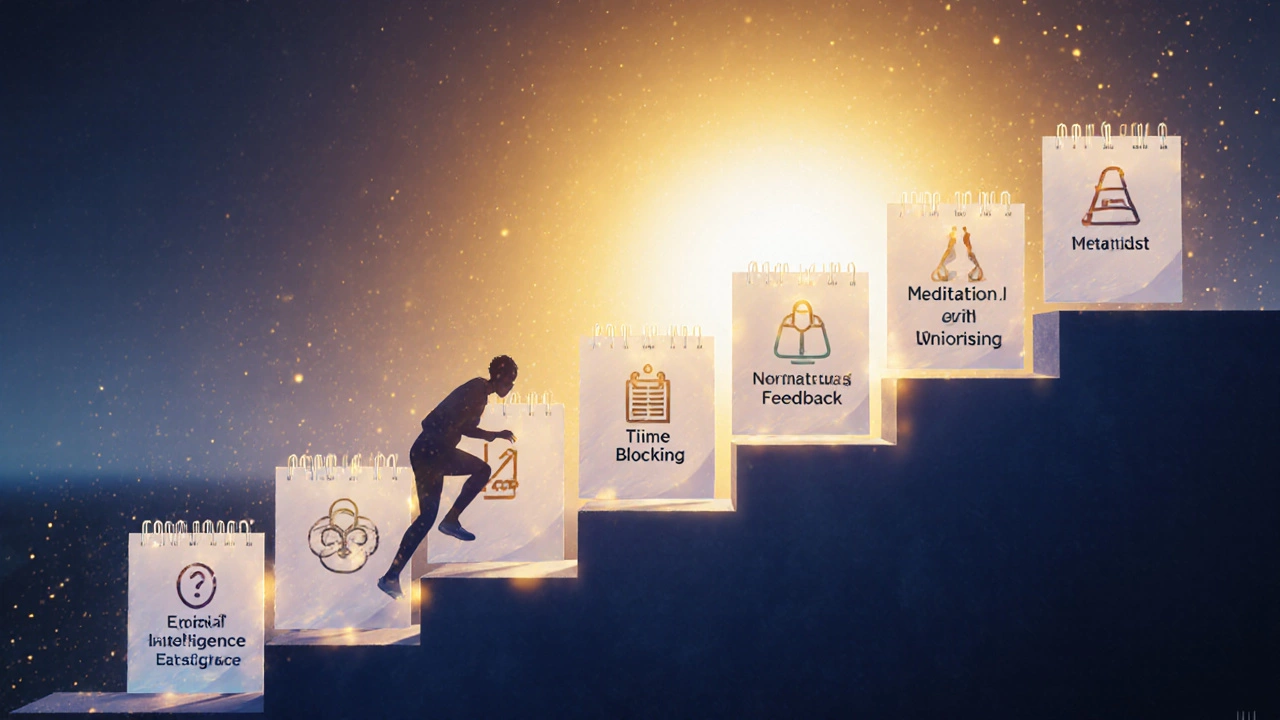Habit Formation Calculator
Estimate Your Habit Formation Timeline
Estimated Habit Formation Time
When you hear the term self growth the process of intentionally improving your abilities, habits, and mindset, you might wonder where to start. The good news is that self‑growth isn’t a mystical journey reserved for gurus; it’s a series of concrete actions you can take every day.
Understanding the Core Elements of Personal Development
Most successful self‑improvement plans revolve around a handful of proven concepts. Below are the building blocks you’ll encounter repeatedly.
- Habit Formation the science of turning small actions into automatic behaviors
- Goal Setting the practice of defining clear, measurable outcomes
- Mindset the underlying belief system that shapes how you interpret challenges
- Journaling a reflective habit that records thoughts, progress, and obstacles
- Meditation a mental training technique for focus and emotional regulation
- Continuous Learning the ongoing acquisition of new skills and knowledge
- Time Management strategies for allocating your hours to high‑impact activities
- Emotional Intelligence the ability to recognize, understand, and manage emotions in yourself and others
- Feedback Loop a systematic way of reviewing results and adjusting actions
Step‑by‑Step Blueprint for Real Growth
- Clarify Your Why: Write a short paragraph answering why you want to improve. When the purpose is compelling, you’ll stick to the plan longer.
- Choose One Habit Formation method to test for 30 days. The simplest is the "Cue‑Routine‑Reward" loop: identify a trigger, define the action, and reward yourself.
- Set a SMART Goal Setting objective. Make it Specific, Measurable, Achievable, Relevant, and Time‑bound.
- Adopt a growth‑oriented Mindset. Replace "I can’t" with "I’m learning how to".
- Start a nightly Journaling habit. Record what you did, what worked, and one adjustment for tomorrow.
- Spend at least five minutes in Meditation each morning. Focus on breath; notice thoughts without judging them.
- Allocate a weekly slot for Continuous Learning. It could be a podcast, a short course, or a book chapter.
- Apply the "Time Blocking" technique from Time Management. Reserve solid blocks for deep work, break tasks into 90‑minute sprints.
- Practice Emotional Intelligence by labeling your feelings during stressful moments. This simple act reduces reactivity.
- Every Sunday, run a Feedback Loop: review journal entries, measure progress against your SMART goal, and tweak the next week’s plan.
Comparing Popular Habit‑Building Frameworks
| Framework | Core Idea | Typical Time to Stick | Best For |
|---|---|---|---|
| Cue‑Routine‑Reward | Identify trigger, perform action, reward | ~21 days | Simple daily habits |
| Implementation Intentions | "If‑Then" planning (If X, then I will Y) | ~14 days | Complex, goal‑oriented actions |
| Atomic Habits 2‑Minute Rule | Start with a version that takes ≤2 minutes | ~10 days | Overcoming procrastination |

Practical Tips to Avoid Common Pitfalls
- Don’t multitask. Trying to change several habits at once dilutes focus.
- Track consistency, not perfection. Missing a day isn’t failure; it’s data for your feedback loop.
- Keep rewards immediate. Long‑term benefits are motivating, but the brain needs short‑term payoff.
- Adjust cues if they’re too weak. A sticky note on the fridge works better than a vague intention.
- Seek external accountability. Share your goal with a friend or join an online community.
Putting It All Together: A 30‑Day Action Plan
Below is a ready‑made calendar that integrates every element discussed. Feel free to reorder based on personal preferences.
| Day | Focus | Action |
|---|---|---|
| 1‑3 | Why & Goal | Write your purpose statement and a SMART goal. |
| 4‑6 | Habit Loop | Choose a cue, habit, and reward; log each attempt. |
| 7 | Review | Run your first feedback loop; adjust cue if needed. |
| 8‑10 | Mindset | Replace limiting thoughts with growth statements; journal daily. |
| 11‑13 | Meditation | 5‑minute breath focus each morning; note mood changes. |
| 14 | Mid‑Month Check | Measure progress against goal; celebrate small wins. |
| 15‑18 | Learning | Complete a short online module related to your goal. |
| 19‑21 | Time Blocking | Schedule two 90‑minute deep‑work sessions. |
| 22‑24 | EI Practice | During conflicts, name the emotion before responding. |
| 25‑27 | Feedback Loop | Revise habit cues, refine rewards, update journal. |
| 28‑30 | Wrap‑Up | Assess goal achievement, set the next 30‑day target. |

Frequently Asked Questions
How long does it really take to develop a new habit?
Research varies, but most people see a noticeable automaticity after 21‑30 days of consistent practice. The exact timeline depends on the habit’s complexity and how strong the cue‑reward loop is.
Can I improve multiple areas of my life at once?
It’s better to focus on one habit or mindset shift at a time. Once that’s stable, layer another. This prevents overwhelm and keeps the feedback loop clean.
What if I miss a day?
Missing a day isn’t a failure; it’s data. Log the miss, examine the trigger, and adjust. Consistency over perfection is the key metric.
Do I need a journal to track progress?
A journal is a low‑cost, high‑impact tool. It captures thoughts, clarifies patterns, and fuels your feedback loop. However, a digital note app works just as well if you prefer typing.
How does emotional intelligence fit into self growth?
Emotional intelligence lets you recognize internal resistance, manage stress, and relate better to others. Higher EI accelerates habit adoption because you’re less likely to self‑sabotage.
Next Steps
Pick one item from the 30‑day plan, set a reminder, and start tomorrow. The moment you take the first action, the growth engine turns on. Remember, self‑growth is a marathon, not a sprint - but every mile counts.






